If you want to know about the fire tower or stairwell pressurization system or firefighting in multistory developments, please click the link.
Means of egress or exits in a building refer to the safe and accessible routes that occupants can use to exit a building during an emergency or evacuation. The main purpose of means of egress is to ensure that people can evacuate a building quickly and safely in case of an emergency, such as a fire, earthquake, or other hazardous situations.
1) Means of Egress (Exits)
A means of egress is a continuous and unobstructed way of exit travel from any point in a building or structure to a public way and consists of three separate and distinct parts.
- Exit Access
- Exit
- Exit Discharge
i) Exit Access
- Portion of a means of egress which leads to an entrance to an exit.
- It includes the room or space in a building in which a person is located and the aisles, stairs, ramps, passageways, corridors and the doors that must be traversed on the way to an exit.

- Exit access through adjoining room permitted.
- Egress through adjacent spaces is permitted if those spaces are accessory to the area served, nonhazardous, and provide access to an exit.
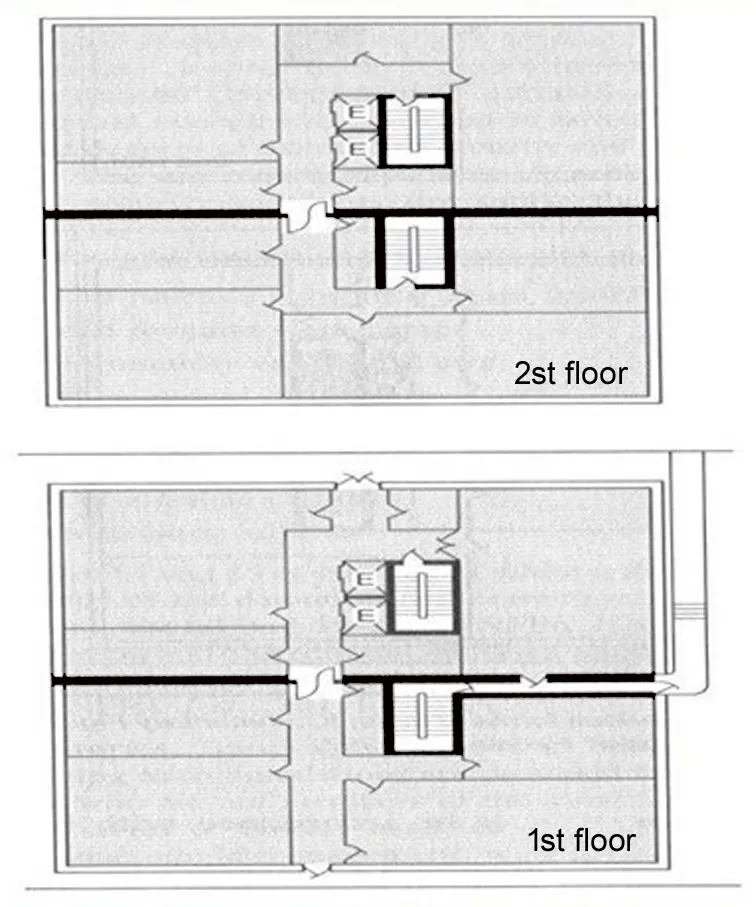
- Spaces constituting exit access
Note
- A common path of travel is desirable in exit access which leads to two independent directions to separate exits.
- Capacity of exit access the width of corridors, aisles or ramps required for exit access shall be sufficient to ensure a smooth flow of occupants to the exit. Where a corridor is the only way of access to an exit, the corridor width shall not be less than the calculated exit width.
- Objects like tables, chairs or any other temporary / permanent structures in exit access corridors shall be avoided as this may result in congestion and also impeding smooth flow of personnel during emergencies.
- In order to ensure that each element of the means of egress can be effectively utilized, they shall all be properly lit and marked. Lighting shall be provided with emergency power back-up in case of power failures. Also, exit signs of adequate size, marking, location, and lighting shall be provided so that all those unfamiliar with the location of the exits may safely find their way.
- Exit access to fireman’s lift and refuge area on the floor shall be step free and clearly signposted with the international symbol of accessibility.
- Exit access shall not pass-through storage rooms, closets or spaces used for similar purpose.
- The calculation of capacity of exit access shall be in accordance with given below (Types of exit access and exits).
ii) Exit
Is that portion of a means of egress which is separated from all other spaces of the building or structure by construction or equipment as required to provide a protected way of travel to the exit discharge.
i) Number of exits
The minimum required number of exits in a building shall be determined based on occupant load calculation and width required per person (as shown in the figure below)

- As appropriate to the type of exit for respective occupancies, subject to complying with maximum travel distance requirement’s (shown in the figure below).
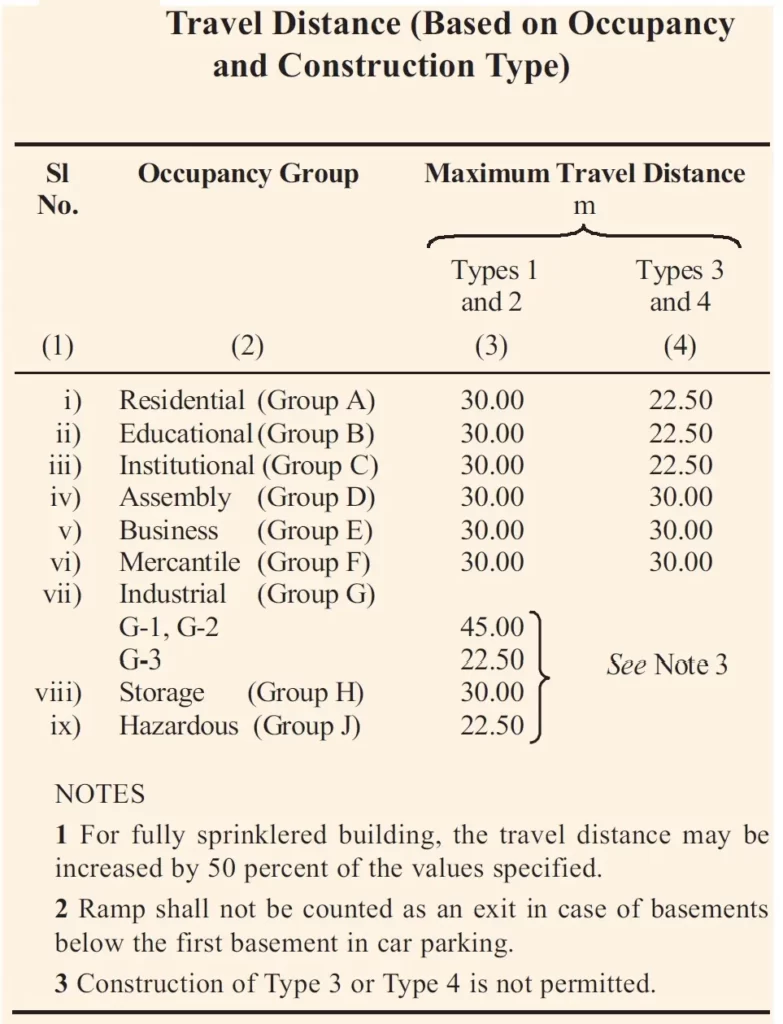
ii) Arrangement of exits
- Exits shall be so located that the travel distance on the floor shall not exceed the distance given in figure above.
- Travel distance shall be measured from the most remote point within a storey or a mezzanine floor along the natural and un- obstructed path of horizontal or vertical egress travel to the door to an exit.
- The dead-end corridor length in exit access shall not exceed 6 m for educational, institutional and assembly occupancies. For other occupancies, the same shall be 15 m (see Figure below)
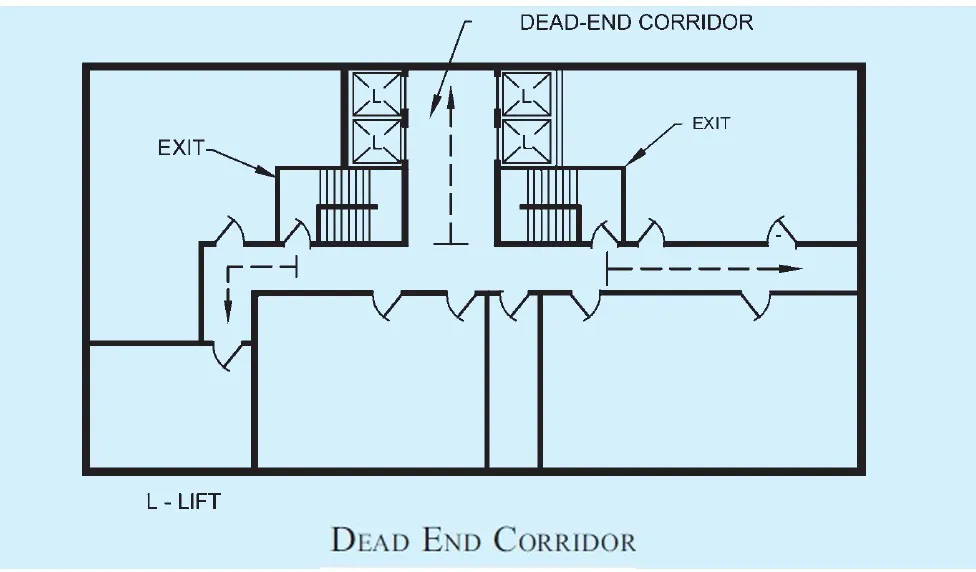
- Exits shall be placed as remote from each other as possible and shall be arranged to provide direct access in separate directions from any point in the area served.
iii) Capacities of means of egress
- Exit capacity is the number of people that can pass through a stairway, and level components (door and corridor) and ramps. The total capacity of all the respective means of egress serving a floor shall be sufficient to allow egress of the entire population of the floor.
- The unit of exit width, used to measure the capacity of any exit, shall be 500 mm. A clear width of 250 mm shall be counted as an additional half unit. Clear widths less than 250 mm shall not be counted for exit width.
- Width per person for stairways, and level components and ramps shall be determined using the capacity factors in accordance with given figure below.
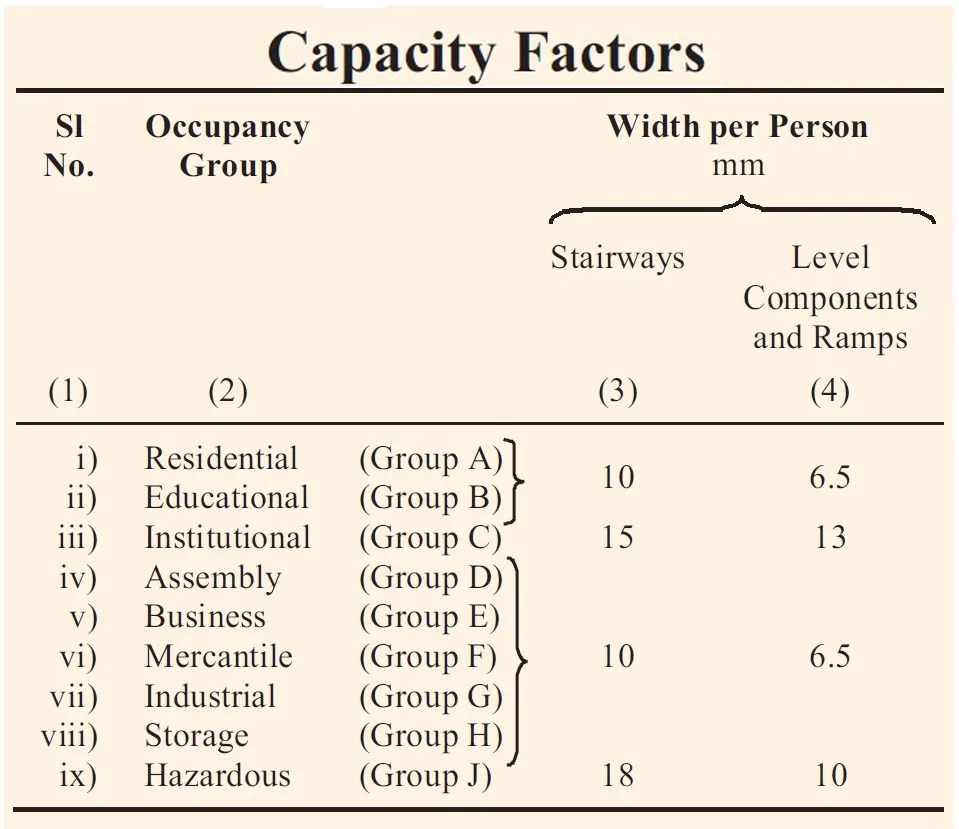
For example, if an exit doorway measures 1000 mm in clear width, it would be defined as providing exit capacity for 1000/6.5 occupants, that is, 153 persons (say 150 persons) and number of such exit doorways can then be calculated depending on the occupant load.
- When calculating stairways, level components and ramps and other exit means, the capacity of the entire system shall have to be based upon the minimum capacity available from any part of the system. The corridor, if so, provided shall also to be planned with consideration of exit access adequacy for the number of occupants. Further, consider the situation of doors opening to an exit stairway. If the stairway provides an exit capacity of 150 persons, and the doors leading into the stairway provide an exit capacity of 153 persons, the overall exit system would be considered to provide the minimum exit capacity of only 150 persons afforded by the stairway. The exit planning will be limited by the most restrictive exit calculation under the means of egress.
- In the procedures for determining required egress capacity, the number of required means of egress is based on a floor-by-floor consideration, rather than the accumulation of the occupant loads of all the floors. However, the number of means of egress cannot decrease as an occupant proceeds along the egress path.
iv) Types of exit access and exits
- Various types of exit access and exits are doorways, corridors and passageways, horizontal exits, internal staircases, exit passageways, external staircases and ramps.
- Requirements for each are as detailed below.
a) Doorways
- Every exit doorway shall open into an enclosed stairway or a horizontal exit of a corridor or passageway providing continuous and protected means of egress (see Figure below on unaccepted arrangement of doors in a stair).
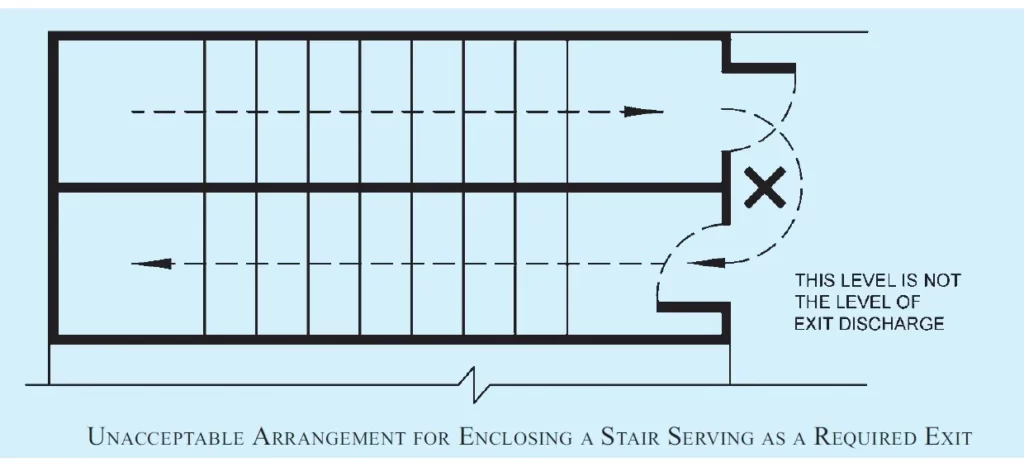
- No exit doorway shall be less than 1000 mm in width except assembly buildings, where door width shall be not less than 2000 mm (see Figure below).

Doorways shall be not less than 2000 mm in height.
- Exit doorways shall be operable from the side which they serve, without the use of a key.
- Mirrors shall not be placed on exit doors and in exits to avoid confusion regarding the direction of exit.
- Revolving doors can be accepted as a component in a means of egress where the following requirements are fully complied with:
- Doors shall be capable of collapsing to a book fold position with parallel egress paths, of width not less than 1000 mm.
- Doors shall not be located within 3 m of the foot or top of stairs or escalators. A dispersal area shall be provided between the stairs or escalators and the doors.
- Each revolving door shall be provided with a hinged door in the same wall within 3 m thereof, with same exiting capacity.
- Each revolving door shall be considered as capable of exiting only 50 persons.
- All fire rated doors and assembly shall be provided with certificate and labels prominently indicating the manufacturer’s identification, door details covering door type, serial/batch number, month and year of manufacture, fire resistance rating, etc. The doors and assembly shall be certified with all prescribed hardware such as hinges, locks, panic bars, door closer, and door viewers.
- Access controlled doors – Access controlled doors and electromagnetic doors shall fall under this category. These shall meet the following requirements:
- Doors shall have fire rating as per the requirements at the location of installation.
- Activation of the building automatic sprinkler or fire detection system, if provided, shall automatically unlock the doors in the direction of egress, and the doors shall remain unlocked until the automatic sprinkler system or fire-alarm system has been manually reset.
- Loss of power to the part of the access control system that locks the doors shall automatically unlock the doors in the direction of egress.
- A manual release device shall be provided in the readily accessible vicinity of the egress door with a signage “PUSH TO EXIT” and when the same is operated, it shall result in direct interruption of power to the lock, independent of the access control system electronics.
- Turnstiles – Turnstiles or similar devices that restrict travel to one direction or are used to collect fares or admission charges shall not be placed so as to obstruct any required means of egress unless door openings of required width are available within 3 m thereof. Turnstiles or such similar devices shall also be disengaged through automatic or manual intervention to allow egress in the direction of exit.
- Doors in folding partition shall not be treated as approved means of egress.
b) Corridors and passageways of means of egress
- Corridors and passageways shall be of width not less than the calculated aggregate width of exit doorways leading from them in the direction of travel to the exit (see the figure below).

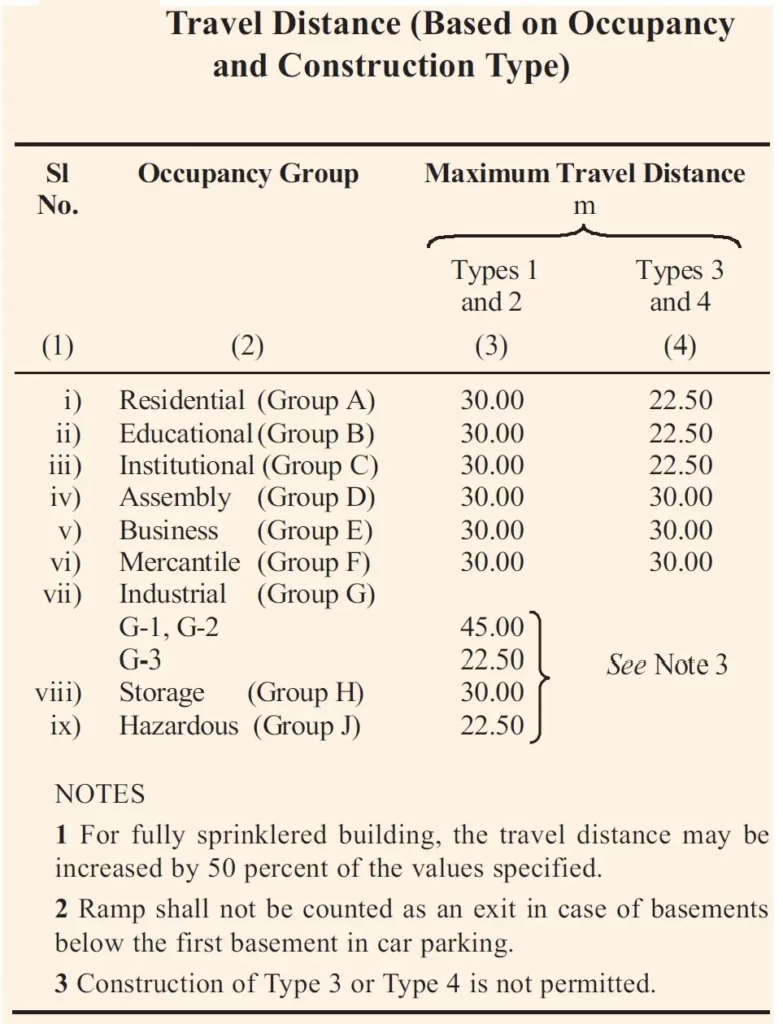
- In the case of buildings where there is a central corridor, which is part of exit access, the doors of rooms (except for rooms having assembly occupancy) shall open inwards to permit smooth flow of traffic in the corridor.
3) Exit discharge
Is that portion of a means of egress between the termination of an exit and a public way.
2) Capacity of means of egress
The occupant load in any building or portion thereof shall not be assumed to be less than the number determined by dividing the floor area assigned to the use of the occupant load factor.
1 Unit of Exit Width (UEW) = 55cm
Capacity of Exit: Level egress component including class A ramps = 100 person/UEW = (0.55cm/person)
Inclined egress component including class B ramps = 60 person/UEW = (0.92cm/person)
Stairs = 45 person/UEW = (1.22cm/person)
Example
Gross(Office)Floor Area = 1,860 sq. m.
Occupant Load Factor = 9.3 gross sq.m. (OLF) per person
Number of Occupant = GFA/OLF = 200 person
3) Gross Floor Area/Net Area
Example
Gross Floor Area = 10,000 sq.m.
OLF (office) = 9.3 sq.m./person
No. of Occupant = 10,000/9.3
= 1,075.27 persons at level egress component:
Total Width of Exit = 1,075 persons x 0.55cm/person
TWE = 591.25 cm
No. of exits = TWE/Width of Exit (ranges 71cm–122cm for doors)
= 591.25cm/122cm
= 4.85 say 5 exits of 122cm clear width
4) Measurement of travel distance to exit
The maximum travel distance to any occupied space to at least one exit, measure in accordance with the following requirements, shall not exceed the limits specified by the Codes. (Par 5-6.1, NFPA)
5) Measurement of travel distance
The travel distance to an exit shall be measured on the floor or other walking surface along the centerline of the natural path of travel starting from the most remote point subject to occupancy, curving around any corners or obstructions with one foot clearance therefrom, and ending at the center of the doorway or other point at which the exit begins. Where measurement includes stairs, the measurement shall be taken in the plane of the thread nosing.
6) Ergess components
- Exit door swings in direction of egress
- Exit doors are not locked when building is occupied
- Exit doors are kept closed (doors close and latch)
- Access to and from the exit is not obstructed
In addition, means of egress should be properly maintained and kept free from any obstructions or hazards that could impede the safe evacuation of occupants. Building owners and occupants should also be familiar with the building’s evacuation plan and procedures to ensure a safe and efficient evacuation during an emergency.